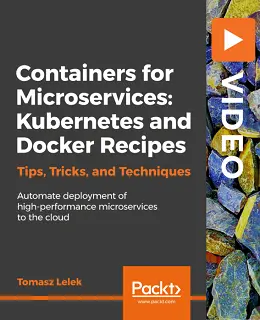Containers for Microservices: Kubernetes and Docker Recipes [Video]

Containers for Microservices: Kubernetes and Docker Recipes [Video]
English | MP4 | AVC 1920×1080 | AAC 48KHz 2ch | 2 Hours | 475 MB
eLearning | Skill level: All Levels
Containers for Microservices: Kubernetes and Docker Recipes [Video]: Troubleshoot and deploy microservices in the cloud
Docker is popularly used to build, ship, and run containers, and Kubernetes is used to orchestrate Docker containers. Instead of being rival technologies, Docker and Kubernetes complement each other through every stage of deployment. The best way of running a microservice app architecture is via containers as they are lightweight runtime environments and can be run on physical or virtual machines.
If you already have some experience working with Kubernetes and Docker, this course is a perfect guide with recipes that are proven to work with microservice containers using Kubernetes and Docker. Each video supplies a recipe containing a tip, trick, and technique to help you work more effectively and synergistically with Kubernetes and Docker to build, ship, run, and manage containers for your applications.
You will implement tips to help you select a microservice architecture that is appropriate for your application and business, and explore best practices to follow when building and deploying microservices for your apps throughout the workflow. You will use Docker to package and ship your apps and Kubernetes to deploy, manage, and scale them. Optionally, you can also implement best practices when deploying apps to the cloud (AWS) and multi-container microservices. You will improve performance and security in containers and microservices (and facilitate smooth communication within them), ensuring there is no data loss. You will master troubleshooting techniques to help diagnose and debug issues relating to operations, networking, and storage; you will also learn to avoid these to ensure your workflow is efficient.
- Create secure Docker images to ship your apps
- Avoid operational anti-patterns with Kubernetes and Docker tweaks
- Leverage a Docker Enterprise Edition Hub to share your images
- Use advanced Docker commands for management and networking
- Use advanced Kubernetes commands for better security and performance
- Use and troubleshoot the Kubernetes proxy, DNS, and its networking stack
- Create secure connections between services with no data loss
- Debug and troubleshoot Kubernetes storage with advanced debugging commands
- Implement service discovery with Kubernetes’ advanced networking techniques
- Perform zero-downtime deployments of your production apps
By the end of the course, you will be confident to efficiently build and deploy containers for microservices using Docker and Kubernetes.